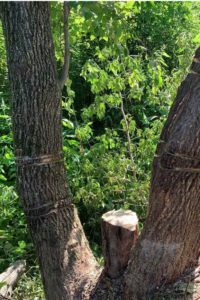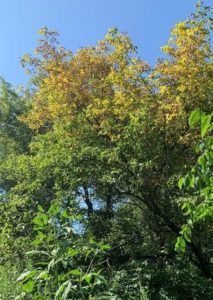End of the Summer Season

By Tarryn Hanson, Rochester Maples Field Crew Leader / AmeriCorps Member

Just a few short weeks ago my crew and I were spending the hot days of July foliar spraying plants and picking black-cap raspberries in Whitewater WMA. We gathered enough berries that I had enough to make a raspberry crumb cake and raspberry jam for everyone on my crew to have. Now, though all the raspberries are all eaten and gone, and the plants are starting to change; my crew is finishing their term and they will be going back to college and to new jobs.

For the last few weeks of working together, we have been girdling boxelder trees at a new site at Hoffman WMA in order to create a buffer zone around existing agricultural fields. In the next few years these fields will be planted with native prairie species; girdling the boxelder trees will help prevent the trees from taking over before the newly planted prairie species can thrive. Girdling is a technique in which two lines are cut into the bark of a tree — going through the inner living layer and cutting off nutrient flow to the leaves — killing the tree.
Depending on tree species different techniques and herbicides can be used to achieve the management goal. Boxelders are a particularly hardy tree and will resprout frequently if damaged, so we have been treating these trees with a double girdle method (pictured) and an herbicide application. This will kill the tree without having to take the time to cut it and clear the debris, and creates standing snags to provide habitat for birds and other wildlife. Over the course of our last few weeks working at this site we have been able to see our treatment working. The leaves on the trees in the area we started have already begun yellowing and dying, which makes it feel even more like fall is starting too early. With fall comes the start of classes for some and for others remaining means that fall burn season will be starting soon, followed by our typical winter projects.

